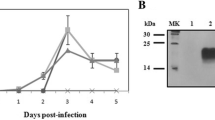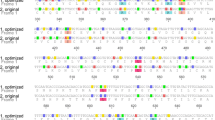Abstract
Fip-gts, a fungal immunomodulatory protein (Fip) isolated from Ganoderma tsugae (gts), has been reported to possess therapeutic effects in the treatment of cancer and autoimmune disease. To cost-effectively produce Fip-gts and bypass the bottleneck involved in its time-consuming purification from G. tsugae, in this study, we incorporated the SPbbx secretion signal into recombinant baculovirus for expressing glycosylated and bioactive rFip-gts in baculovirus-infected insect cells and Trichoplusia ni larva. This is the first study to employ the aerosol infecting T. ni larva with recombinant baculovirus for economical and high-level production of foreign proteins. In this study, one purification could yield 10 mg of rFip-gts protein merely from ∼100 infected T. ni larvae by aerosol inoculation, corresponding to 5 L (5 × 109 cells) of the infected Sf21 culture. In addition, the rFip-gts purified from T. ni larvae could induce the expression of interleukin-2 in murine splenocytes with an immunoresponsive level similar to that induced by LZ-8 (a known potent immunomodulatory protein purified from Ling zhi, Ganoderma lucidum). Thus, our results demonstrated that the larva-based baculovirus expression system can successfully express rFip-gts with the assembling capability required for maintaining immunomodulatory and anticancer activity. Our approach will open a new avenue for the production of rFip-gts and facilitate the immunoregulatory activity of rFip-gts available in the future.






Similar content being viewed by others
References
Kino, K., Yamashita, A., Yamaoka, K., Watanabe, J., Tanaka, S., Ko, K., et al. (1989). Isolation and characterization of a new immunomodulatory protein, ling zhi-8 (LZ-8), from Ganoderma lucidium. Journal of Biological Chemistry, 264, 472–478.
Ko, J. L., Hsu, C. I., Lin, R. H., Kao, C. L., & Lin, J. Y. (1995). A new fungal immunomodulatory protein, FIP-fve isolated from the edible mushroom Flammulina velutipes and its complete amino acid sequence. European Journal of Biochemistry, 228, 244–249.
Hsu, H. C., Hsu, C. I., Lin, R. H., Kao, C. L., & Lin, J. Y. (1997). Fip-vvo, a new fungal immunomodulatory protein isolated from Volvariella volvacea. Biochemical Journal, 323, 557–565.
Sheu, F., Chien, O. J., Hsieh, K. Y., Chin, K. L., Huang, W. T., Tsao, C. Y., et al. (2009). Purification, cloning, and functional characterization of a novel immunomodulatory protein from Antrodia camphorata (bitter mushroom) that exhibits TLR2-dependent NF-kB activation and M1 polarization within murine macrophages. Journal of Agricultural and Food Chemistry, 57, 4130–4141.
Lin, W. H., Hung, C. H., Hsu, C. I., & Lin, J. Y. (1997). Dimerization of the N-terminal amphipathic alpha-helix domain of the fungal immunomodulatory protein from Ganoderma tsugae (Fip-gts) defined by a yeast two-hybrid system and site-directed mutagenesis. Journal of Biological Chemistry, 272, 20044–20048.
Chu, C. L., Chen, D. Z. C., & Lin, C. C. (2011). A novel adjuvant Ling zhi-8 for cancer DNA vaccines. Human Vaccines, 7, 1161–1164.
Wu, C. T., Lin, T. Y., Hsu, H. Y., Sheu, F., Ho, C. M., & Chen, E. I. (2011). Ling zhi-8 mediates p53-dependent growth arrest of lung cancer cells proliferation via the ribosomal protein S7-MDM2-p53 pathway. Carcinogenesis, 32, 1890–1896.
Lin, C. C., Yu, Y. L., Shih, C. C., Liu, K. L., Hong, L. Z., Chen, J. D., et al. (2011). A novel adjuvant Ling zhi-8 enhances the efficacy of DNA cancer vaccine by activating dendritic cells. Cancer Immunology, Immunotherapy, 60, 1019–1027.
Yeh, C. H., Chen, H. C., Yang, J. J., Chuang, W. I., & Sheu, F. (2010). Polysaccharides PS-G and protein LZ-8 from Reishi (Ganoderma lucidum) exhibit diverse functions in regulating murine macrophages and T lymphocytes. Journal of Agricultural and Food Chemistry, 58, 8535–8544.
Wang, S. Y., Hsu, M. L., Hsu, H. C., Tzeng, C. H., Lee, S. S., Shiao, M. S., et al. (1997). The anti-tumor effect of Ganoderma lucidum is mediated by cytokines released from activated macrophages and T lymphocytes. International Journal of Cancer, 70, 699–705.
Tanaka, S., Ko, K., Kino, K., Tsuchiya, K., Yamashita, A., Murasugi, A., et al. (1989). Complete amino acid sequence of an immunomodulatory protein, Ling zhi-8 (LZ-8). Journal of Biological Chemistry, 264, 16372–16377.
Lai, N. S., Lin, R. H., Lai, R. S., Kun, U. C., & Leu, S. C. (2001). Prevention of autoantibody formation and prolonged survival in New Zealand Black/New Zealand white F1 mice with an ancient Chinese herb, Ganoderma tsugae. Lupus, 10, 461–465.
Hsu, H. Y., Hua, K. F., Wu, W. C., Hsu, J., Weng, S. T., Lin, T. L., et al. (2008). Reishi immuno-modulation protein induces interleukin-2 expression via protein kinase-dependent signaling pathways within human T cells. Journal of Cellular Physiology, 215, 15–26.
Xu, X., Yan, H., Chen, J., & Zhang, X. (2011). Bioactive proteins from mushrooms. Biotechnology Advances, 29, 667–674.
Jeurink, P. V., Noguera, C. L., Savelkoul, H. F. J., & Wichers, H. J. (2008). Immunomodulatory capacity of fungal proteins on the cytokine production of human peripheral blood mononuclear cells. International Immunopharmacology, 8, 1124–1133.
Wang, P. H., Yang, S. F., Chen, G. D., Han, C. P., Chen, S. C., Lin, L. Y., et al. (2009). Human nonmetastatic clone 23 type 1 gene suppresses migration of cervical cancer cells and enhances the migration inhibition of fungal immunomodulatory protein from Ganoderma tsugae. Reproduction Science, 14, 475–485.
Liao, C. H., Hsiao, Y. M., Lin, C. H., Yeh, C. S., Wang, J. C., Ni, C. H., et al. (2008). Induction of premature senescence in human lung cancer by fungal immunomodulatory protein from Ganoderma tsugae. Food and Chemical Toxicology, 46, 1851–1859.
Liao, C. H., Hsiao, Y. M., Hsu, C. P., Lin, M. Y., Wang, J. C., Huang, Y. L., et al. (2006). Transcriptionally mediated inhibition of telomerase of fungal immunomodulatory protein from Ganoderma tsugae in A549 human lung adenocarcinoma cell line. Molecular Carcinogensis, 45, 220–229.
Dong, Y., & Shi, J. R. (2006). Application of primary culture technique to traditional Chinese medicine research. Zhong Xi Yi Jie He Xue Bao, 4, 90–93.
Jinn, T. R., Wu, C. M., Tu, W. C., Ko, J. L., & Tzen, J. T. C. (2006). Functional expression of Fip-gts, a fungal immunomodulatory protein from Ganoderma tsugae in Sf21 insect cells. Bioscience, Biotechnology, and Biochemistry, 70, 2627–2634.
Groner, A. (1986). Specificity and safety of baculoviruses. In R. R. Granados & B. A. Federici (Eds.), The biology of baculoviruses. Boca Raton: CRC.
Kost, T. A., Condreay, J. P., & Jarvis, D. L. (2005). Baculovirus as versatile vectors for protein expression in insect and mammalian cells. Nature Biotechnology, 23, 567–575.
Jarvis, D. L. (2003). Developing baculovirus-insect cell expression systems for humanized recombinant glycoprotein production. Virology, 310, 1–7.
Kulakosky, P. C., Hughes, P. R., & Wood, H. A. (1998). N-linked glycosylation of a baculovirus-expressed recombinant glycoprotein in insect larvae and tissue culture cells. Glycobiology, 8, 741–745.
Perez-Filgueria, D. M., Resino-Talavan, P., Cubillos, C., Angulo, I., Barderas, M. G., Barvena, J., et al. (2007). Development of a low-cost, insect larvae-derived recombinant subunit vaccine against RHDV. Virology, 364, 422–430.
Liu, Y., DeCarolis, N., & van Beek, N. (2007). Protein production with recombinant baculoviruses in lepidopteran larvae. Methods in Molecular Biology, 388, 267–280.
Kondo, H., Ino, M., Suzuki, A., Ishizaki, H., & Iwami, M. (1996). Multiple gene copies for bombyxin, an insulin-related peptide of the silkmoth Bombyx mori: structural signs for gene rearrangement and duplication responsible for generation of multiple molecular forms of bombyxin. Journal of Molecular Biology, 259, 926–937.
Wu, C. M., Wu, T. Y., Kao, S. S., Ko, T. L., & Jinn, T. R. (2008). Expression and purification of a recombinant Fip-fve protein from Flammulina velutipes in baculovirus-infected insect cells. Journal of Applied Microbiology, 104, 1354–1362.
Jinn, T. R., Kao, S. S., Tseng, Y. C., Chen, Y. J., & Wu, T. Y. (2009). Aerosol infectivity of a baculovirus to Trichoplusia ni larvae: an alternative larval inoculation strategy for recombinant protein production. Biotechnology Progress, 25, 384–389.
Vaughn, J. L., Goodwin, R. H., Tompkins, G. J., & McCawley, P. (1977). The establishment of two cell lines from the insect Spodoptera frugiperda (Lepidoptera; Noctuidae). In Vitro, 13, 213–217.
O’Reilly, D. R., Miller, L. K., & Luckow, V. A. (1992). Baculovirus expression vector: a laboratory manual. New York: W.H. Freeman and Company.
Hung, C. C., & Hwan, J. S. (1988). The mass rearing method of major insect pests: Asian corn borer, Ostrinia furnacalis, guava mealy bug, Planococcus minor and beet armyworm, Spodoptera exigua. Taiwan: Annual Report TACTRI.
Giraudo, C. L. C., Rumi, L., & Pasqualini, C. D. (1976). An improved method for PHA-culturing mouse lymphocytes using Ficoll-Hypaque gradient. Bollettino dell'Istituto Sieroterapico Milanese, 55, 304–307.
Wermerskirchen, A. S., LaTocha, D. H., & Clarke, B. L. (2000). Adrenocorticotropic hormone controls Concanavalin A activation of rat lymphocytes by modulating IL-2 production. Life Science, 67, 2177–2187.
O’Connell, K. P., Kovaleva, E., Campbell, J. H., Anderson, P. E., Brown, S. G., Valdes, J. J., et al. (2007). Production of a recombinant antibody fragment in whole insect larvae. Molecular Biotechnology, 36, 44–51.
Pham, M. Q., Naggie, S., Wier, M., Cha, H. J., & Bentley, W. E. (1999). Human interleukin-2 production in insect (Trichoplusia ni) larvae: effects and partial control of proteolysis. Biotechnology and Bioengineering, 62, 175–182.
Medin, J. A., Hunt, L., Gathy, K., Evans, R. K., & Coleman, M. S. (1990). Efficient, low-cost protein factories: expression of human adenosine deaminase in baculovirus-infected insect larvae. Proceedings of the National Academy of Sciences, 87, 2760–2764.
Haak-Frendscho, M., Kino, K., Sone, T., & Jardieu, P. (1993). Ling zhi-8: a novel T-cell mitogen induces cytokine production and upregulation of ICAM-1 expression. Cell Immunology, 150, 101–113.
Lin, Y. L., Liang, Y. C., Tseng, Y. S., Huang, H. Y., Chou, S. Y., Hseu, R. S., et al. (2009). An immunomodulatory protein, Ling zhi-8, induced activation and maturation of human monocyte-derived dendritic cells by the NF-kB and MAPK pathways. Journal of Leukocyte Biology, 86, 877–889.
Inngjerdingen, K. T., Kiyohara, H., Matsumoto, T., Petersen, D., Michaelsen, T. E., & Diallo, D. (2007). An immunomodulating pectic polymer from Glinus oppositifolius. Phytochemistry, 68, 1046–1058.
Arkin, S., Naprstek, B., Guarini, L., Ferrone, S., & Lipton, J. M. (1991). Expression of intercellular adhesion molecule-1 (CD54) on hematopoietic progenitors. Blood, 77, 948–953.
Hubbard, A. K., & Rothlein, R. (2000). Intercellular adhesion molecule-1 (ICAM-1) expression and cell signaling cascades. Free Radical Biology & Medicine, 28, 1379–1386.
Amaout, M. A., Mahalingam, B., & Xiong, J. P. (2005). Integrin structure, allostery, and bidirectional signaling. Annual Review of Cell and Development Biology, 21, 381–405.
Acknowledgments
The authors would like to thank the China Medical University and National Science Council of the Republic of China for financially supporting this research under Contract No. CMU 97-199 and NSC-98-2324-B-039-005.
Author information
Authors and Affiliations
Corresponding author
Additional information
Tzong-Yuan Wu and Hsin-An Chen contributed equally to this study.
Rights and permissions
About this article
Cite this article
Wu, TY., Chen, HA., Li, FY. et al. High-Level Expression, Purification and Production of the Fungal Immunomodulatory Protein-Gts in Baculovirus-Infected Insect Larva. Appl Biochem Biotechnol 169, 976–989 (2013). https://doi.org/10.1007/s12010-012-0049-2
Received:
Accepted:
Published:
Issue Date:
DOI: https://doi.org/10.1007/s12010-012-0049-2




